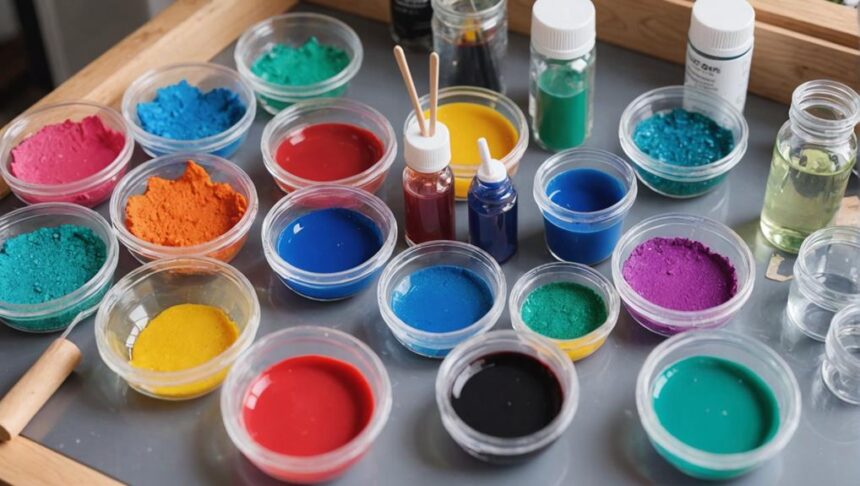For resin art newbies, the top three must-haves are epoxy resin and hardener, silicone molds, and disposable gloves. Epoxy resin, when mixed just right with a hardener, creates clear, sturdy, and incredible pieces that can be jazzed up with colors and glitter. Silicone molds are like magic printers, letting you pop out your creations effortlessly and cleanly, perfect for all types of cool designs. And don’t forget those disposable gloves—nitrile is best—to shield your hands from any sticky mess and skin irritations. Stick around to uncover more essential tips and tricks for your resin art journey!
Key Takeaways
- Epoxy resin and hardener are crucial for creating durable, clear resin art with various mixing ratios like 1:1 or 2:1.
- Silicone molds provide flexible, reusable options for intricate resin designs, making them essential for beginners.
- Disposable nitrile gloves protect hands from chemicals and provide superior strength and dexterity.
- Epoxy resin can be customized with colorants and glitter, enhancing artistic versatility.
Epoxy Resin and Hardener
Epoxy resin and hardener are essential components in resin art, prized for their clarity, durability, and versatile applications.
Mixing techniques are vital here—you need to get the ratio just right. Most brands call for a 1:1 or 2:1 ratio of resin to hardener. Imagine baking a cake: if you mess up the recipe, you get a gooey mess, right? The same goes for resin. Mixing the components precisely guarantees the curing process goes smoothly, avoiding sticky, uncured spots that can ruin your masterpiece.
The curing process for epoxy resin usually takes anywhere from 24 to 72 hours. That’s like waiting for your birthday cake to bake—totally worth it, but it takes patience. This time can change based on the temperature and humidity of your workspace. Too hot, and it might cure too fast; too cold, and it could take forever.
With epoxy resin, you can get really creative. Add some colorants, or maybe a dash of glitter, to make your piece stand out. Plus, many resins are non-toxic and safe for indoor use, so no need to worry about nasty fumes while you’re creating your next art project.
Silicone Molds
Silicone molds are indispensable tools in resin art, prized for their flexibility, reusability, and ability to produce intricate designs with ease. Whether you’re making coasters, jewelry, or decorative pieces, these molds allow you to create various shapes and patterns without much hassle.
One of the best things about silicone molds is their non-stick surface. This means you can easily pop out your cured resin pieces without worrying about damaging those delicate details. Plus, they come in all sorts of sizes and styles, which means you can experiment with different projects and creative techniques. Want to make a detailed dragonfly pendant or a sleek, modern coaster? There’s a mold for that!
Mold maintenance is also a breeze. You can clean them with mild soap and water, and they’re good to go for the next round. This reusability not only makes them cost-effective but also helps reduce waste, which is always a win in my book.
Moreover, many silicone molds are designed with specific details and textures that can enhance the final appearance of your resin projects. This allows for greater creativity and adds an extra layer of fun to your resin art journey.
Disposable Gloves
When working with resin, protecting your hands from harmful chemicals and potential skin irritation is paramount, making disposable gloves an indispensable part of your toolkit.
Choosing the right glove types can make a significant difference in your resin art experience. Nitrile gloves are highly recommended over latex gloves due to their superior strength, chemical resistance, and lower likelihood of causing allergic reactions.
Here’s a quick guide to help you understand why disposable gloves are essential:
- Chemical Protection: Resin contains chemicals that can be harmful to your skin. Nitrile gloves offer robust protection against these chemicals, ensuring your hands stay safe.
- Allergy Concerns: Latex gloves can cause allergic reactions in some individuals. Nitrile gloves are less likely to trigger allergies, making them a safer choice.
- Snug Fit: Always choose gloves that fit snugly. A tight fit enhances dexterity and reduces the risk of tearing, allowing you to work with precision.
- Single Use: Disposable gloves should be thrown away immediately after use. Reusing gloves can lead to cross-contamination and reduce their protective effectiveness.
Frequently Asked Questions
What Are the Materials Needed for Resin Art?
For resin art, necessary materials include epoxy resin and hardener, mixing cups and stir sticks for accurate color mixing, and silicone molds. Additionally, guarantee resin safety with protective gear like nitrile gloves and safety goggles.
What Do I Need to Start a Resin Hobby?
To start a resin hobby, you need epoxy resin and hardener, accurate measuring cups, mixing sticks for precise mixing techniques, silicone molds, PPE for resin safety, and a heat gun or torch to eliminate bubbles.
What Are the Three 3 Types of Commonly Used Resin?
The three commonly used types of resin are epoxy resin, known for its clarity and durability; polyester resin, which is less expensive but highly toxic; and UV resin, which cures quickly under UV light and is ideal for smaller projects.
How to Do Resin Art Beginners?
To begin resin art as a beginner, start by resin mixing with a precise 1:1 ratio, ensuring thorough stirring. Adhere to safety precautions such as wearing nitrile gloves and safety goggles to protect against skin irritation and harmful fumes.
Conclusion
In conclusion, starting resin art requires just a few essential materials.
Epoxy resin and hardener form the core components, allowing the creation of stunning designs.
Silicone molds offer flexibility and ease in shaping the artwork.
Disposable gloves are vital for safety, protecting the skin from potentially harmful chemicals.
With these three basic supplies, beginners can confidently start their resin art journey, exploring endless creative possibilities while ensuring safety and precision in their projects.


Leave a Reply